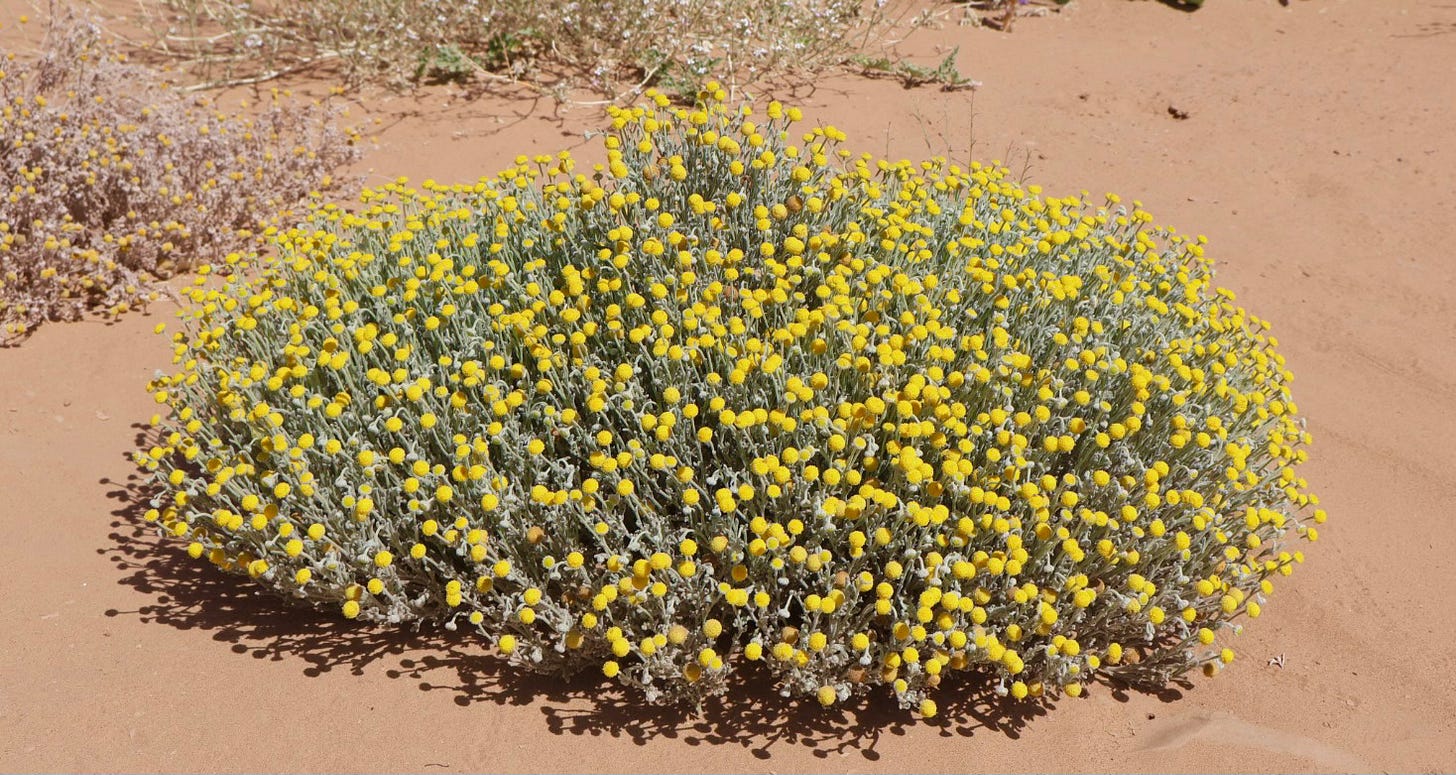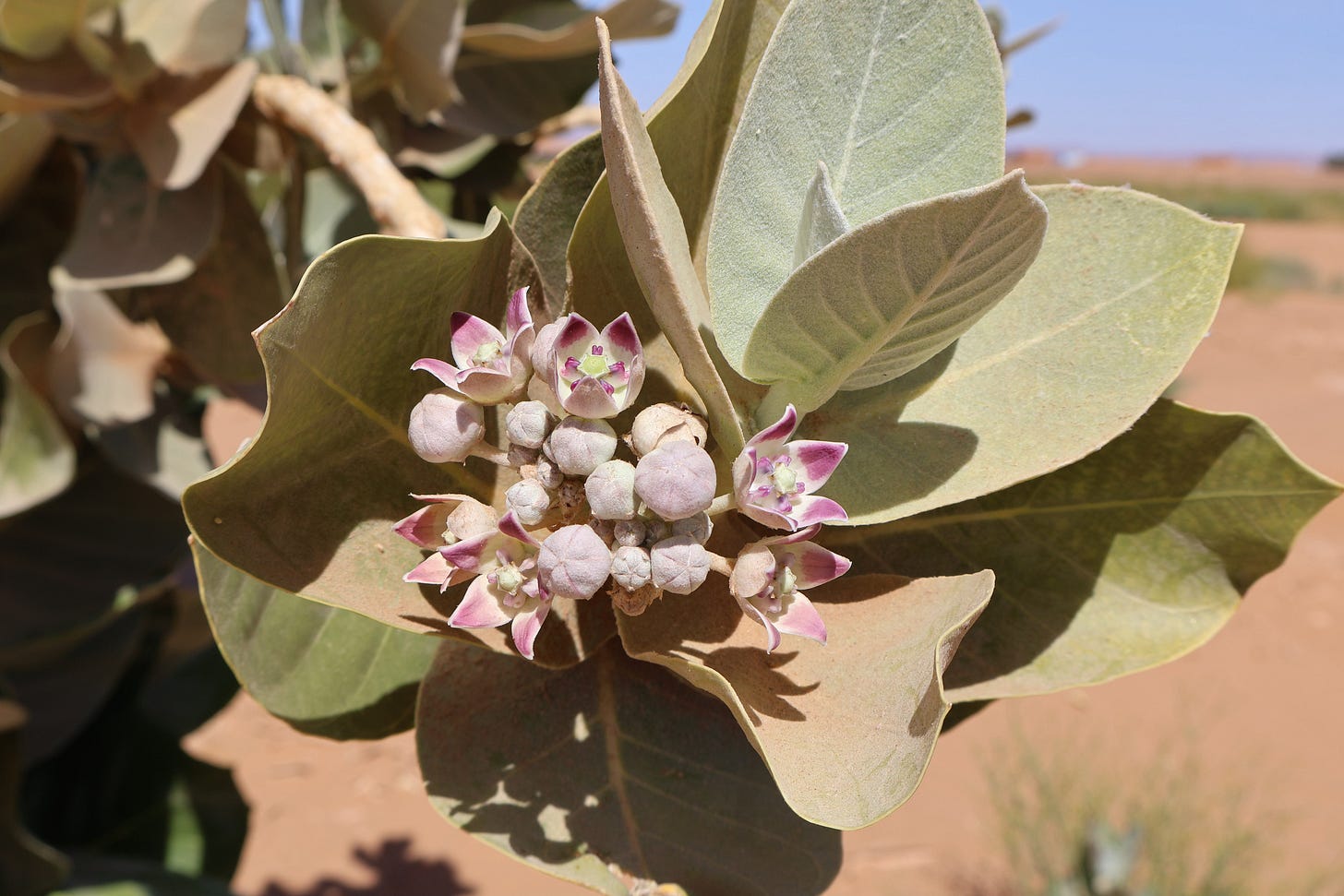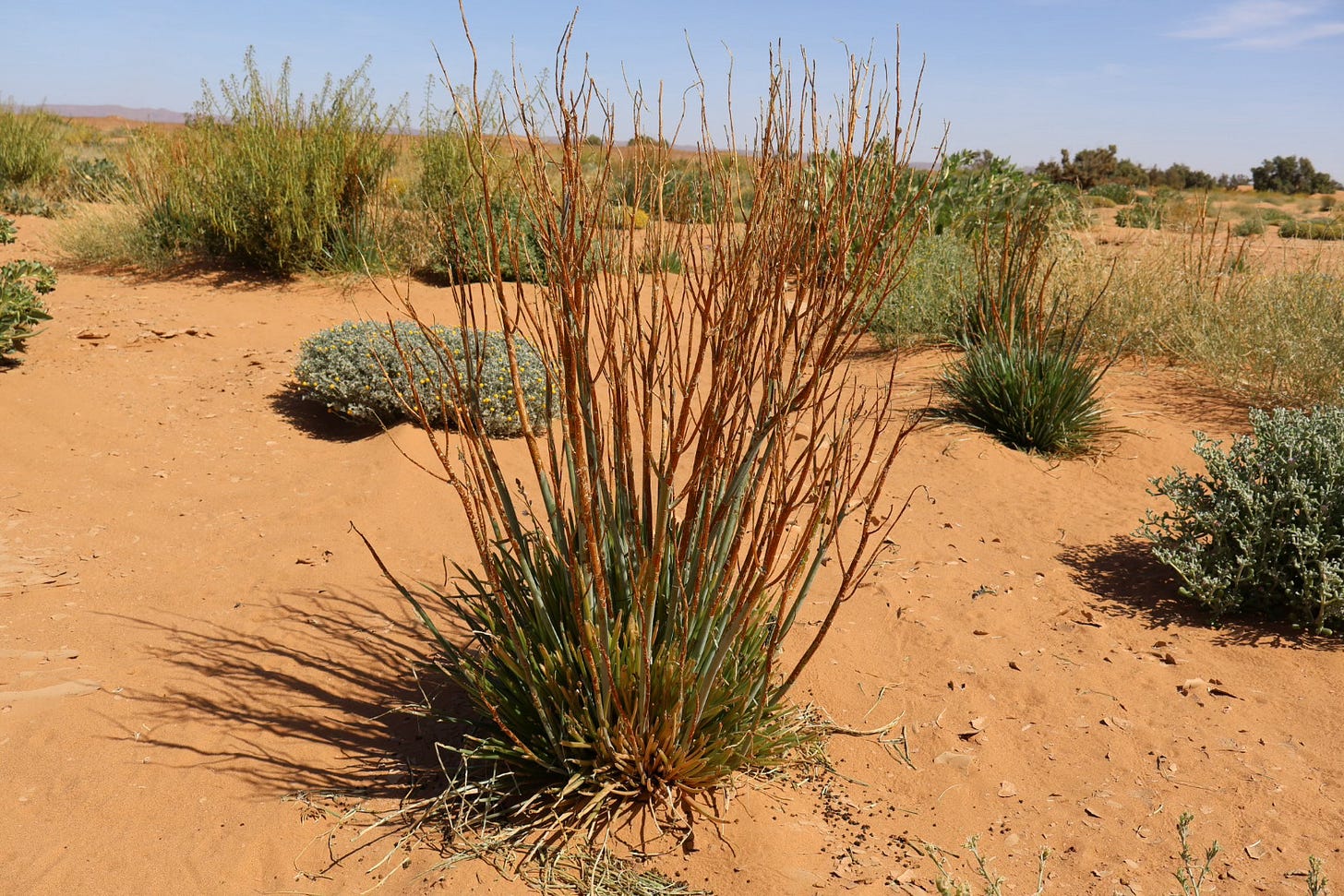Plants of the Sahara
*most* of the plants that I found in the sand dunes of Morocco
You didn’t think I’d spend a month in the desert and not talk about the plants, did you? Of course not. It’s like you dont even know me. When I first arrived, I expected endless sand—just dunes and more dunes. But to my surprise, the desert was way greener than I imagined. A few months before, there had been massive rains—apparently the biggest flood season in 40 years, according to Mbark, the owner of the camp where we were volunteering.
Jordan and I spent almost three weeks volunteering at a campsite in the Moroccan Sahara (you can read all about that adventure here), but this post is all about the plants. Some I came across on my own during walks, others were the ones Mbark had us pull up to feed his goats. Either way, I saw a lot, learned a lot, and did even more research after the fact. Here are just a few of the many fascinating plants I encountered in the desert.
Brocchia cinerea
Also known as Ash Buttons and Ashy Cotula, Brocchia cinerea is often found in the desert regions of Northern Africa and the Arabian peninsula. It has a deep and wide root system that helps stabilize sandy soils and efficiently absorb the scarce moisture in the desert. The plant itself is very soft almost succulent looking with striking yellow flowers.
Brocchia cinerea has been used in herbal medicine, particularly in the treatment of colic, coughs, diarrhea, and digestive issues. It is also used for pain relief, fever reduction, and inflammation. The plant is commonly consumed in tea blends, either for its medicinal properties or to enhance the flavor of the tea. The plant also has antimicrobial and research is being conducted on the antibacterial effects, meaning the plant could also have wound healing properties.
Calotropis procera
Also known as giant milkweed, Sodom apple, or rubber bush, Calotropis procera is native to Northern and Tropical Africa, Western Asia, and South Asia. Apparently the name “Sodom apple” comes from ancient texts that claim it grew in the biblical area of Sodom. Even though the plant is not native to the Americas, it has been cultivated there to support monarch butterfly caterpillars.
The plant has wide, soft green leaves and produces five-petaled purple and yellow flowers that remind me of wax plant (Hoya) flowers. What really caught my attention was the way it grows—old stems die while new ones sprout, making it look like a skeleton is emerging from the tree. Its fruit resembles a green apple but is filled with dandelion-like seeds attached to long white hairs, which can be used for textile production.
We were told to use cation when handling this plant. Its milky sap contains compounds that can act as heart poisons and may irritate the skin and eyes. Despite being considered invasive in some regions, Calotropis procera holds significant medicinal potential. Various parts of the plant are used in traditional medicine to treat ailments such as leprosy, ulcers, and liver diseases. Ongoing research is exploring its pharmaceutical applications as a natural alternative to synthetic drugs.
Citrullus colocynthis
Commonly known as bitter apple, Citrullus colocynthis resembles a small watermelon vine but bears hard, bitter fruits. The plant contains cucurbitacins, making it unsafe for consumption without proper processing.
In order to eat the fruit, you need to go through several rounds of boiling to reduce the toxicity and extreme bitterness before it can be pickled and consumed. Traditionally, it has also been used as a potent purgative and laxative. Beyond its laxative properties, it has been used to treat diabetes, liver problems, and intestinal issues. Additionally, the roots possess purgative properties and have been utilized in treating jaundice, rheumatism, and urinary diseases. Recent studies are looking into the plant’s broader medicinal potential, given its rich history in traditional remedies
Tetraena gaetula
Tetraena gaetula is a semi-succulent subshrub native to the Canary Islands and Western Sahara, thriving primarily in desert or dry shrubland biomes. This plant has small white or pink flowers that bloom almost year-round. When the leaves are crushed, they emit a distinct bitter and salty taste.
In Moroccan traditional medicine, Tetraena gaetula has been utilized as an antispasmodic and antidiabetic. New research is investigating its potential effects on the immune system and the usage as an antidepressant. Additionally, the plant has been used to relieve stomach pains, a common ailment in harsh desert environments.
Moricandia arvensis
Also referred to as violet cabbage or purple mistress, Moricandia arvensis is a species of flowering plant in the Brassicaceae family. It has a broadly western Mediterranean distribution. This plant is recognized for its attractive purple flowers and is often found in fields and open areas. As a member of the Brassicaceae family, Moricandia arvensis contributes to carbon fixation, capturing CO₂ from the atmosphere and cycling it back into the biosphere.
This is one of the plants that we gathered for Mbark’s goats, and instead of pulling it straight out of the ground, we sliced the plant off of the roots. When doing this, we noticed a distinct peanut butter smell. Not only do the goats like this plant, but the camels were often eating it.
Hyoscyamus muticus
Known as Egyptian henbane, Hyoscyamus muticus is a perennial herb or shrub. It belongs to the nightshade family and is characterized by fleshy, almost succulent-like leaves and striking purple flowers. This plant is cultivated worldwide for its pharmaceutical properties but also grows wild in desert regions, like here.
Traditionally it is used as a painkiller and, at times, as a recreational drug. Although in high dosages it can be fatal. The Berber people have historically used this plant as a fish poison. When collecting plants for the goats, we were told to wash our hands immediately if we accidentally touch it to prevent accidental poisoning. Medicinal applications include grinding the leaves into a poultice for pain relief and smoking dried leaves to treat asthma or for their intoxicating effects. The seeds can also be roasted and used to prepare intoxicating drinks. The plant also has a cool history in magical practices and is associated with witchcraft.
Asphodelus tenuifolius
Commonly known as onion weed, Asphodelus tenuifolius is native to North Africa, Southern Europe, the Middle East, and South Asia. It has become an invasive species in regions like California. The plant grows between 12 to 30 inches tall and features numerous smooth, nearly cylindrical hollow leaves resembling those of an onion but without the characteristic scent and taste.
The plant also has beautiful flowers and seed pods that are not shown in this photo because the plant happens to be a favorite snack of the Striped Hawkmoth Caterpillar, Hyles livornica, who eats the flowers and the soft flesh of the plant.
Traditionally, the plant has been used for medicinal and therapeutic properties including treating rheumatic pain and inflammatory, digestive and circulatory complications. The seeds can also be used as a diuretic and to treat toothache.
Cleome Africana
Also known as Cleome arabica or Cleome amblyocarpa .The native range of this species is north Africa, it is also found in other arid regions such as Arabian peninsula It is an annual that grows primarily in the desert or dry shrublands. This is one of the plants that we would often pull up for Mbark’s goats, and while doing so (especially with bare hands) you notice just how much resin the plant holds. I liked pulling this one out of the ground because the deep tap roots were not as difficult to remove as plants like Moricandia arvensis.
This species is characterized by its red flowers and distinctive seed pods. The plant emits a strong aroma, which, while I enjoyed it initially, became overwhelming the more and more I was surrounded by it. Some people, like Mbark, say the smell gives them headaches.
In traditional medicine, the leaves of Cleome africana are utilized to alleviate fevers. A poultice made from mashed leaves is applied to the forehead to help draw out fever. Additionally, an infusion of the leaves is employed to address abdominal and rheumatic pains.
As you can see, the seed pods of this plant hold many lightweight fuzzy seeds, and the plant itself holds many seed pods. These seeds are easily dispersed by the wind, facilitating the plant's propagation across vast desert landscapes.
There were many other plants in the desert, but these are most of the plants I interacted with and saw on a day-to-day basis. It was so interesting learning about all of these plants from Mbark, and the other local residents who have been living with these plants for years, and also very fun to come back and do my own research on these plants and try to correctly ID them.
Thanks for reading, I know this post is a bit different from my usual posts, but I had a lot of fun making it! If you’re still here, I would really appreciate if you could take two minutes to fill out this little survey, or leave a comment of what type of stuff you would like to hear more of in my upcoming blogs!!
xx abby

















I’m fascinated by this skill of yours—please make more posts like this! 😍
I’m a big proponent of plant medicine, so this one hit a special place in my heart